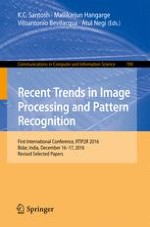2017 | Book
Recent Trends in Image Processing and Pattern Recognition
First International Conference, RTIP2R 2016, Bidar, India, December 16–17, 2016, Revised Selected Papers
Editors: K.C. Santosh, Mallikarjun Hangarge, Vitoantonio Bevilacqua, Atul Negi
Publisher: Springer Singapore
Book Series : Communications in Computer and Information Science
